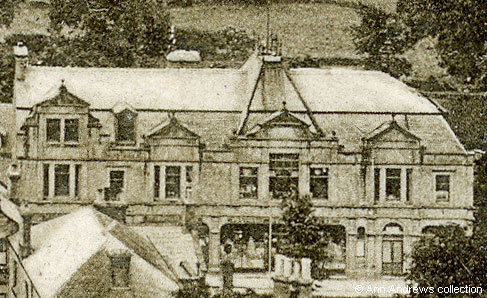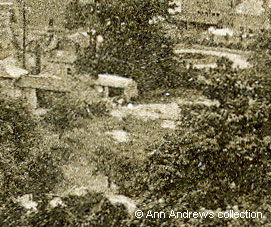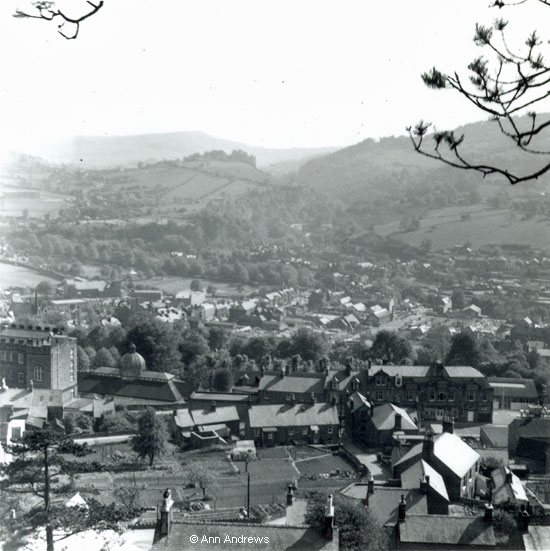The spectacular view across the valley towards Starkholmes, High Tor
and the valley of Matlock Dale was taken from high up on the Bank,
photographed from garden of the house on Cavendish Road where the
web mistress lived for a number of years (see bottom photo)[1].
A wing of the former Smedley's Hydro on Smedley Street is on the
left, almost in the middle is the distinctive dome of Smedley's
Winter Garden (opened 1900) and houses and shops opposite the junctions
of Wellington Street and Smith Road. On the right, partially hidden
by the shops, is the Smedley's United Methodist Free Chapel in
the grounds of the Hydro, though by the time the picture was taken
this time is was being used as a dynamo house. There is a horse
waiting patiently outside the church.
Smith Road, named after the Matlock businessman Job Smith[2],
is the narrow road (bottom, right of centre) that joins Smedley
Street. On the right hand side of the junction is the former Malvern
House Hydro, the establishment Job Smith ran and which he bought
in 1886[3].
Although this picture doesn't show it there is an interesting
triangular carving, incorporating a concave shell, over the corner
doorway. Malvern House was bought by Smedley's Hydro after the
First World War and used as staff accommodation.

Co-op, the Central Grocery |
The Co-operative movement had a strong presence on Matlock for
over a hundred years[4].
It began as the Industrial & Provident Society Ltd
in 1863 but the Matlock & District Co-operative Society Limited
became part of the Derwent Valley Co-operative Society Limited.
In May 1891 Matlock Industrial and Provident Society submitted
plans to the Council for a new Co-operative Hall in Smedley Street[5].
In June the same year it was reported that Matlock Industrial and
Provident Society were about to build a block of business premises
and houses on Smedley Street[6].
This enlargement of the top image shows the three storey building,
that has a frontage of thirty yards and was built of dressed ashlar
stone. It was opened in June 1893. Three hundred people were
present for the "inauguration", with tea followed by
entertainment and presided over by Dr Moxon[7].
There were three shops on the ground floor - drapery, boots and
grocery - the building was also the headquarters for the Society.
The Co-operative Hall, which seated 300, was on the first floor
and accommodation was provided the manager. Cellars and a number
of store rooms were underneath the building. Bread was baked here
for many years, in the 1960s delivered the fresh loaves by van
to households in the neighbourhood. The Co-op bank was also housed
in the building at one stage although it closed some time ago.
Adjoining the Co-op building, on its left (also shown on the top
image), are houses that have a date stone of 1904 and which help
date this picture.

Enlargement of land between Wellington Street and Smith Road
It is not know if the gardens between Smith Road and Smedley Street
were allotments, private gardens or a market garden but next to
them is either a builder's yard or timber merchant's premises
and there there appear to be roof trusses stacked up in the centre.
This may have been the Wellington Street business of the Antliff
Brothers[8].
 |
|
On the left is another enlargement, this time
showing the rubbish tip next to the Town Hall which was something
that received a number of complaints in the late 1890s. Look
at the top image. It is just above the houses that join on
to the Co-op building[9]. |

July 1964 |
The final image is a photograph that was taken from the garden of
The Rowans on Cavendish Road in July 1964. The buildings in the
foreground hadn't changed greatly in the intervening years although
Smedley's Church had been demolished. It was replaced by a modern
block in the hydro's grounds, with what appears to be an entrance
onto Farmer's garage forecourt - you can just see the petrol pumps
on the forecourt. The gap in the fence is closed off today and
the pumps have gone, with Farmer's now located in a modern showroom
on the opposite side of the road. Almost opposite the forecourt
is the single storey building which housed a gentleman's and women's
hairdressing salons. Stuart Woodley had moved to the premises in
either the late 1950s; his business had previously been in one
of the shops under the hydro, where the County Offices are today.
 There is a coloured
version of this view, published as one of their Artistic Series by
A. P. Co. See Just
Images, Matlock (Matlock from Matlock Bank) There is a coloured
version of this view, published as one of their Artistic Series by
A. P. Co. See Just
Images, Matlock (Matlock from Matlock Bank)
 Google image of Smith
Road and the two buildings of Malvern House Hydro Google image of Smith
Road and the two buildings of Malvern House Hydro
|
References (coloured
links are to transcripts or more information elsewhere on this web
site):
[1] The Cavendish Road house referred
to was built by Harry Douglas, manager of Smedley's, and lived
in for many years by him and his family. We lived there in the
1960s.
[2] See Biographies
- Smith, Job and Bank Road & the Steep-Gradient Tramway.
[3] "Derbyshire Times",
12 June 1886. A Birmingham auctioneer called Mr. Howell sold Lot
2, Malvern House Hydropathic Establishment It was bought by Mr.
Job Smith, the occupier, for £450.
[4] See Letterheads
for the Industrial and Provident as well as The
Derwent Valley Co-Operative Society Ltd. (scroll down). The first
directory entry was Harrod's 1870 Directory (not transcribed). The
first transcribed entry was in Kelly's
1876 Directory and they were listed in all the directories up
to 1916 when they had become Matlock Bank Industrial & Provident
Society Limited (Kelly's
1916 Directory).
[5] "Derbyshire Courier",
9 May 1891..
[6] "Derbyshire Times",
20 June 1891. The Co-operative Society and their property.
[7] "Derbyshire Courier",
17 June 1893, Co-operative Hall. James Turner was the architect,
the building contractor was Mr. L. T. Wildgoose and the cost was £2,600.
[8] The Antliffs can be found on Wellington
Street in Kelly's
Directory 1908.
[9] There is more about this on Matlock
Bank & Bridge, late 1890s.
|











 There is a coloured
version of this view, published as one of their Artistic Series by
A. P. Co. See
There is a coloured
version of this view, published as one of their Artistic Series by
A. P. Co. See